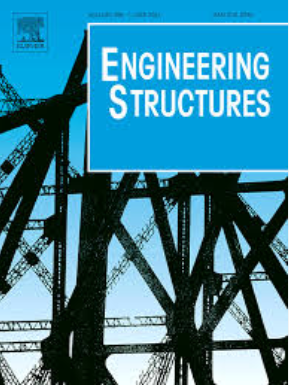Experimental and numerical analysis of the flexural performance of concrete-filled steel tubular members with partial replacement of fine aggregates with sawdust
IF 6.4
1区 工程技术
Q1 ENGINEERING, CIVIL
引用次数: 0
Abstract
This study investigates the structural performance of concrete-filled steel tubular (CFST) beams through experimental and numerical approaches. The CFST beams are prepared with sawdust as a partial replacement for fine aggregates in concrete. A total of fourteen CFST beams are experimentally tested under four-point bending. The sawdust replacement percentages range from 0 % to 25 %. Mechanical properties of the steel tubes and concrete, including compressive and tensile strengths, are evaluated, and the failure modes, ultimate load capacities, initial stiffness, toughness, and ductility indices are analyzed. The results show that sawdust inclusion significantly influences the flexural strength and ductility of the CFST beams, with optimal performance observed at moderate sawdust replacement levels. In addition, finite element analysis is employed to validate the experimental findings. The numerical model closely approximates the load-deflection behavior and failure mechanisms. The study underscores the potential of using sawdust as a sustainable material in structural applications. The study contributes to resource efficiency while maintaining acceptable performance in flexural load scenarios.
木屑部分置换细集料钢管混凝土构件抗弯性能的试验与数值分析
本文通过试验和数值方法对钢管混凝土梁的结构性能进行了研究。CFST梁是用木屑作为混凝土中细集料的部分替代材料制备的。共对14根钢管混凝土梁进行了四点弯曲试验。锯末替换率范围为0 % ~ 25 %。评估了钢管和混凝土的力学性能,包括抗压和抗拉强度,并分析了破坏模式、极限承载能力、初始刚度、韧性和延性指标。结果表明,木屑夹杂物对钢管混凝土梁的抗弯强度和延性有显著影响,在适当的木屑替换水平下,混凝土梁的抗弯性能最佳。此外,采用有限元分析对实验结果进行了验证。该数值模型非常接近荷载-挠曲特性和破坏机制。这项研究强调了木屑在结构应用中作为可持续材料的潜力。该研究有助于提高资源效率,同时在弯曲荷载情况下保持可接受的性能。
本文章由计算机程序翻译,如有差异,请以英文原文为准。
求助全文
约1分钟内获得全文
求助全文
来源期刊

Engineering Structures
工程技术-工程:土木
CiteScore
10.20
自引率
14.50%
发文量
1385
审稿时长
67 days
期刊介绍:
Engineering Structures provides a forum for a broad blend of scientific and technical papers to reflect the evolving needs of the structural engineering and structural mechanics communities. Particularly welcome are contributions dealing with applications of structural engineering and mechanics principles in all areas of technology. The journal aspires to a broad and integrated coverage of the effects of dynamic loadings and of the modelling techniques whereby the structural response to these loadings may be computed.
The scope of Engineering Structures encompasses, but is not restricted to, the following areas: infrastructure engineering; earthquake engineering; structure-fluid-soil interaction; wind engineering; fire engineering; blast engineering; structural reliability/stability; life assessment/integrity; structural health monitoring; multi-hazard engineering; structural dynamics; optimization; expert systems; experimental modelling; performance-based design; multiscale analysis; value engineering.
Topics of interest include: tall buildings; innovative structures; environmentally responsive structures; bridges; stadiums; commercial and public buildings; transmission towers; television and telecommunication masts; foldable structures; cooling towers; plates and shells; suspension structures; protective structures; smart structures; nuclear reactors; dams; pressure vessels; pipelines; tunnels.
Engineering Structures also publishes review articles, short communications and discussions, book reviews, and a diary on international events related to any aspect of structural engineering.
 求助内容:
求助内容: 应助结果提醒方式:
应助结果提醒方式:


